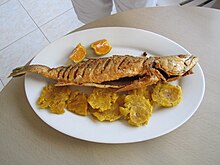Cilus
| Cilus gilberti | |
|---|---|
| Scientific classification | |
| Kingdom: | |
| Phylum: | |
| Class: | |
| Order: | |
| Family: | |
| Genus: | Cilus Delfin, 1900
|
| Species: | C. gilberti
|
| Binomial name | |
| Cilus gilberti (C. C. Abbott, 1899)
| |

The corvina, also known as the corvina drum (Cilus gilberti), is a saltwater fish of the Sciaenidae family (commonly called croakers or drums). It inhabits mostly tropical to temperate coastal waters of the southeastern Pacific along Central and South America. The corvina is highly prized in South America as a food fish.[1]
Description
The corvina is similar in appearance to its relatives the weakfish and spotted seatrout. Its body is blue-grey on top, silvery overall with small scales, and is elongated and somewhat compressed in shape.[2] It has a large mouth and a dorsal fin that is deeply notched between spiny and soft parts. It reaches 40 cm (16 in) or more.[2]
Range and habitat
The corvina is found along the South American Pacific coastline from Chile to Panama,[3] and also in the Galapagos.[2] It inhabits soft bottoms at a depth of 5 to 50 m (16 to 164 ft).[citation needed]
Culinary uses
The corvina has a white and flaky texture and a mild, sweet taste. Cooking methods include grilled, baked, fried, and sushi. It is a popular choice in ceviche.[4][5]
References
- ^ "Cilus gilberti summary page". FishBase.
- ^ a b c Jack Stein Grove; Robert J. Lavenberg (1997). The Fishes of the Galapagos Islands. Stanford University Press. pp. 423–. ISBN 978-0-8047-2289-6.
- ^ Edmundo Murray (2015). A Symphony of Flavors: Food and Music in Concert. Cambridge Scholars Publishing. pp. 176–. ISBN 978-1-4438-8130-2.
- ^ Lonely Planet Food (1 August 2012). The World's Best Street Food: Where to Find it & How to Make it. Lonely Planet. pp. 41–. ISBN 978-1-74321-664-4.
- ^ Douglas Rodriguez (3 July 2012). The Great Ceviche Book, revised. Potter/TenSpeed/Harmony. pp. 20–. ISBN 978-1-60774-455-9.

